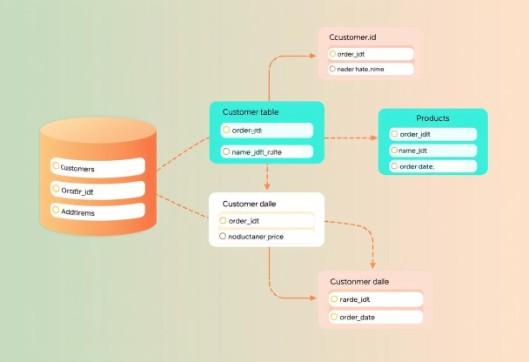




Welcome to this comprehensive SQL tutorial, designed to equip aspiring database developers and students with the essential knowledge and skills needed to navigate the world of relational databases. SQL, or Structured Query Language, is the foundational language for managing and manipulating data. This presentation will guide you through the core concepts, practical applications, and advanced techniques of SQL, transforming you into a proficient database professional.






• Tables, Rows, and Columns
RDBMS organizes data into tables, each with rows and columns, providing a clear and logical structure. This tabular format makes data easy to manage and query, ensuring data integrity and consistency.
• Primary and Foreign Keys
• Schema Definition

• ACID Properties
RDBMS offers robust features like ACID properties (Atomicity, Consistency, Isolation, Durability) to ensure reliable transaction processing. It also supports concurrent access and provides mechanisms for data security and recovery.
• Data Integrity
• Concurrency Control
At its core, RDBMS serves as the backbone for countless applications, from small business websites to massive enterprise systems. Understanding how it stores and manages data is crucial for anyone looking to work with SQL.




Used to create new database objects like tables, views, or indexes. This command defines the structure and attributes of the data you want to store.

These commands are essential for data manipulation. INSERT adds new rows, UPDATE modifies existing rows, and DELETE removes rows from a table, maintaining data currency.


The most frequently used command, allowing you to retrieve data from one or more tables. It enables filtering, sorting, and combining data to extract meaningful insights.

Used to remove existing database objects, such as tables or databases. Exercise caution with this command as it permanently deletes data.
These four fundamental commands form the backbone of SQL, enabling you to interact with and manage your data effectively. Mastering them is the first step towards becoming proficient in database operations.




Joins are used to combine rows from two or more tables based on a related column between them.
Common types include INNER
JOIN, LEFT JOIN, RIGHT JOIN, and FULL JOIN, each serving a specific purpose in data retrieval.
• Combining data from multiple tables
• INNER, LEFT, RIGHT, FULL joins
• Understanding join conditions
A subquery, or inner query, is a query embedded inside another SQL query. They are used to retrieve data that will be used by the main query as a condition to further restrict the data to be retrieved.
• Nested queries for complex filtering
• Can be used in WHERE, FROM, SELECT clauses
• Enhancing query flexibility
While powerful, complex joins and subqueries can impact query performance. Optimizing these queries through proper indexing and efficient design is critical for large datasets.
• Indexing for faster retrieval
• Query optimization techniques
• Avoiding common performance pitfalls
Moving beyond basic commands, joins and subqueries unlock the ability to work with more intricate data relationships, enabling you to build highly sophisticated and efficient queries.




Eliminate repeating groups in tables and create separate tables for each set of related data. Identify each set of related data with a primary key.
Meet all the requirements of 2NF and remove columns that are not directly dependent on the primary key.
Meet all the requirements of 1NF and remove subsets of data that apply to multiple rows of a table and place them in separate tables.
Database normalization is a systematic approach to designing a relational database schema to minimize data redundancy and improve data integrity. It involves breaking down a large table into smaller, well-structured tables.
While there are higher forms of normalization, 3NF is generally considered sufficient for most practical applications, striking a balance between data integrity and performance.








Marks the start of a transaction, grouping multiple SQL statements into a single, atomic unit of work.
Saves all changes made during the transaction permanently to the database, ensuring data consistency.
Undoes all changes made during the transaction, restoring the database to its state before the transaction began, crucial for error handling.
Transactions are vital for maintaining the integrity of data in a multi-user environment. They ensure that operations are either fully completed or fully undone, preventing partial updates and data corruption.





Virtual tables based on the result-set of a SQL query. Views can be used to simplify complex queries, restrict data access, and present data in a customized way.

Pre-compiled SQL code that can be stored in the database and executed repeatedly. They enhance performance, improve security, and reduce network traffic.


Special types of stored procedures that automatically execute when a specific event occurs in the database, such as an INSERT, UPDATE, or DELETE operation.
These advanced database objects provide powerful tools for database developers, enabling them to create more efficient, secure, and maintainable database applications. They automate tasks and streamline data management.



Mastering SQL is crucial for any aspiring database professional. It's the universal language for data interaction.
Consider delving into database administration, data warehousing, or big data technologies.


The database world is constantly evolving. Stay updated with new features and best practices.
The best way to learn is by doing. Set up a local database and experiment with queries and commands.
This tutorial has provided a solid foundation in SQL and database development. The journey to mastery is ongoing, requiring continuous learning and hands-on practice. Embrace the challenges and opportunities in this dynamic field.


